Book Library
Disclaimer: The NVLD Project does not provide professional medical advice, diagnosis or treatment. The contents of this resource list, including text, graphics, and images, are for educational and informational purposes only, and are provided as a service for families and individuals affected by Non-Verbal Learning Disability. Always seek the advice of your physician or other qualified health provider with any questions you may have regarding a medical condition. Never disregard professional medical advice or delay in seeking it because of something you have read on The NVLD Project Site. NVLD does not recommend or endorse any specific tests, physicians, products, procedures, opinions, or other information that may be mentioned on the Site.
 NVLD and Developmental Visual-Spatial Disorder in Children
NVLD and Developmental Visual-Spatial Disorder in Children
Amy Margolis, Ph.D., John M. Davis Ph.D., and Jessica Broitman Ph.D.
This unique volume explores issues related to working with children who have nonverbal learning disability (NVLD). It examines how a child’s psychology – thoughts, feelings, beliefs – affects his or her functioning and learning. In addition, the book addresses how a child’s experiences are processed through individual personality, psychology, culture, environment and economic circumstances, and family dynamics. Using these psychological organizing principles, the book describes how to work most effectively with young patients with NVLD. It offers a new model and definition for understanding NVLD, emphasizing its core deficit of visual-spatial processing.
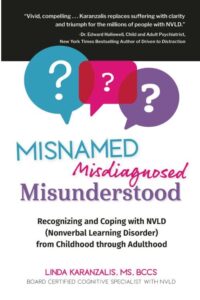 Misnamed, Misdiagnosed, Misunderstood: Recognizing and Coping with NVLD
Misnamed, Misdiagnosed, Misunderstood: Recognizing and Coping with NVLD
Linda Karanzalis
But the vast majority of human communication is non-verbal — body language, facial expressions, and tone of voice. Those with NVLD have trouble interpreting this non-verbal language and must rely on words alone to understand what others mean, which can lead to difficulties. Linda not only empowers others to achieve their goals but also serves as a role model offering understanding, hope, and inspiration to NVLDers of all ages.
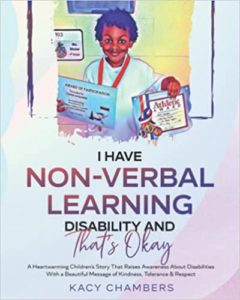 I Have Non-Verbal Learning Disability and That’s Okay
I Have Non-Verbal Learning Disability and That’s Okay
Kacy C Chambers
With a touching story that inspires children and parents alike with an enduring message of kindness and tolerance, I Have Non-Verbal Learning Disability and That’s Okay offers a heartwarming way to raise awareness about disabilities and encourage young children to accept people who are different from them.
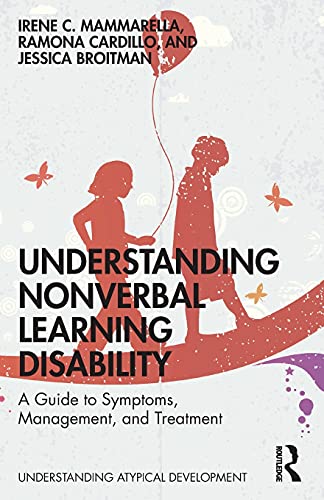 Understanding Nonverbal Learning Disability A Guide to Symptoms, Management, and Tretament 1st Edition
Understanding Nonverbal Learning Disability A Guide to Symptoms, Management, and Tretament 1st Edition
Irene C. Mammarella, Ramona Cardillo, Jessica Broitman
This essential book offers an accessible, evidence-based guide to Nonverbal Learning Disability (NVLD) informed by the most current research, and clinical and educational practice. It provides a thorough explanation of the science behind the condition, alongside ideas, support, and practical tips for managing the everyday challenges of the disorder at school and in family life.
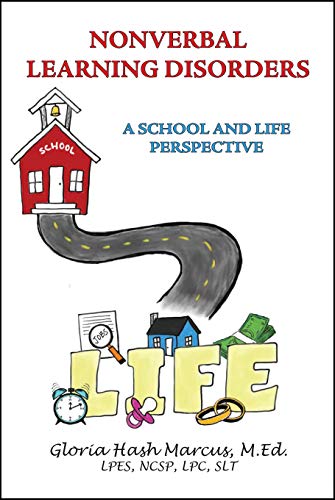 Nonverbal Learning Disorders: A School and Life Perspective
Nonverbal Learning Disorders: A School and Life Perspective
Gloria Hash Marcus
Gloria Hash Marcus’ book was written to assist parents, teachers, and students in understanding the dynamics of students with NVLD. Students with NVLD are often misunderstood by teachers and parents. NLD is a brain-based difference that has many strengths and weaknesses. Areas of strength typically include early speech and vocabulary development, precocious reading skills, and assets with spelling and rote memory skills. Challenging areas include visual-spatial concerns, motor control (including gross and fine motor skills), and social-emotional development. This book features a series of visual and interactive exercises.
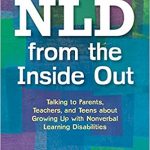 NLD from the Inside Out: Talking to Parents, Teachers, and Teens about Growing Up with Nonverbal Learning Disabilities
NLD from the Inside Out: Talking to Parents, Teachers, and Teens about Growing Up with Nonverbal Learning Disabilities
Michael Brian Murphy
Offering invaluable advice for teenagers and young adults with Nonverbal Learning Disabilities (NLD), this book explains what NLD is, how to understand your NLD brain, and how to thrive socially and academically. The book also includes guidance for parents, teachers and therapists on the issues that people with NLD want them to know.
 Screwed Up Somehow But Not Stupid, Life with a Learning Disability
Screwed Up Somehow But Not Stupid, Life with a Learning Disability
Peter Flom
When Peter Flom was five years old, his parents were told that he had “minimal brain dysfunction” and would never go to college. Peter skipped one year of high school, did college in three years, got his BA at twenty and now has two MAs and a Ph.D. He’s married and has two sons. He also has a different diagnosis: Nonverbal Learning Disability. In “Screwed Up Somehow but Not Stupid,” Peter describes what it’s like to live life with a learning disability, but also with some abilities.
 NLD- Nonverbal Learning Disorder: A Parent’s Guide to Understanding and Helping a Child With a Nonverbal Learning Disorder (Also Known As Nonverbal Learning Disability)
NLD- Nonverbal Learning Disorder: A Parent’s Guide to Understanding and Helping a Child With a Nonverbal Learning Disorder (Also Known As Nonverbal Learning Disability)
Patricia Stanley
Understanding emotions – their own and others’ – poses a major challenge for children with autism spectrum and other social cognitive challenges, causing frustration and misunderstanding and often behavioral outbursts. This collection of easy-to-use activities for children ages 4-18 gives parents, teachers, and others a valuable resource. Through a wide variety of experiences, children learn to identify and respond to their own feelings as well as the feelings of others, thereby improving their chances of maintaining and establishing fulfilling and successful social relationships.
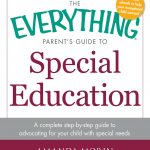 The Everything Parent’s Guide to Special Education: A Complete Step-by-Step Guide to Advocating for Your Child with Special Needs
The Everything Parent’s Guide to Special Education: A Complete Step-by-Step Guide to Advocating for Your Child with Special Needs
Amanda Morin
Children with special needs who succeed in school have one thing in common–their parents are passionate and effective advocates. It’s not an easy job, but with The Everything Parent’s Guide to Special Education, you will learn how to evaluate, prepare, organize, and get quality services, no matter what your child’s disability.
 Smart but Stuck: Emotions in Teens and Adults with ADHD
Smart but Stuck: Emotions in Teens and Adults with ADHD
Thomas E. Brown
This book offers 15 true and compelling stories about intelligent, capable teens and adults who have gotten “stuck” at school, work, and/or in social relationships because of their ADHD. Dr. Brown highlights the often unrecognized role that emotions play in this complex disorder. He explains why even very bright people with ADHD get stuck because they can focus well on some tasks that interest them, but often can’t focus adequately on other important tasks and relationships.
 Life After High School: A Guide for Students with Disabilities and Their Families
Life After High School: A Guide for Students with Disabilities and Their Families
Susan Yellin, Christina Cacioppo Bertsch
Graduating high school and moving on to further education or the workplace brings with it a whole new set of challenges, and this is especially true for students with disabilities. This useful book provides a complete overview of the issues such students and their families will need to consider, and outlines the key skills they will need in order to succeed once they get there.
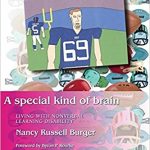 A Special Kind of Brain: Living with Nonverbal Learning Disability
A Special Kind of Brain: Living with Nonverbal Learning Disability
Nancy Russell Burger
Sharing the experience of bringing up a child with nonverbal learning disability (NLD), this warm and accessible book offers advice on subjects ranging across diagnosis and therapy, children’s interaction with each other, suitable activities for a child with NLD and how to discuss NLD with children. An essential guide, this book will reassure, advise and inform parents and professionals who work with children with NLD.
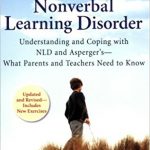 Nonverbal Learning Disorder: Understanding and Coping with NLD and Asperger’s-What Parents and Teachers Need to Know
Nonverbal Learning Disorder: Understanding and Coping with NLD and Asperger’s-What Parents and Teachers Need to Know
Rondalyn Varney Whitney
Millions of children suffer from Nonverbal Learning Disorder, a neurological deficit that prevents them from understanding nonverbal cues like tone of voice and facial expressions. Though they can be exceptionally bright and articulate, these children often have difficulty in social situations, and can become depressed, withdrawn, or anxious.
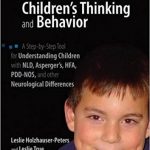 Making Sense of Children’s Thinking and Behavior: A Step-by-Step Tool for Understanding Children with NLD, Asperger’s, HFA, PDD-NOS, and other Neurological Differences
Making Sense of Children’s Thinking and Behavior: A Step-by-Step Tool for Understanding Children with NLD, Asperger’s, HFA, PDD-NOS, and other Neurological Differences
Leslie Holzhauser-Peters and Leslie True
This book offers a tool for understanding children with neurological differences. Often, the child’s actions are misunderstood and, consequently, they are unfairly punished. The authors’ Systematic Tool for Analyzing Thinking (STAT) provides a step-by-step method for understanding a child’s behavior by revealing the thought processes behind it.
 The Social Success Workbook for Teens: Skill-Building Activities for Teens with Nonverbal Learning Disorder, Asperger’s Disorder, and Other Social-Skill Problems
The Social Success Workbook for Teens: Skill-Building Activities for Teens with Nonverbal Learning Disorder, Asperger’s Disorder, and Other Social-Skill Problems
Barbara Cooper MPS and Nancy Widdows MS
Making friends is a skill like any other-there are rules to follow, ways to measure your progress, and reasons why some people are better at it than others. Although it may seem like this skill comes naturally to those who don’t have Asperger’s disorder, nonverbal learning disorder (NLD), or other problems relating to others, the reality is that even the most popular people must constantly hone their abilities in order to make new friends and keep the friends they already have. This workbook includes forty activities you can do to recognize and use your unique strengths, understand the unspoken rules behind how people relate to each other, and improve your social skills.
 Helping Children with Nonverbal Learning Disabilities to Flourish: A Guide for Parents and Professionals
Helping Children with Nonverbal Learning Disabilities to Flourish: A Guide for Parents and Professionals
Marilyn Martin
Martin presents a comprehensive developmental profile of children with NLD. She helps parents and professionals to identify learners with NLD and insure they receive early intervention. Offering practical advice on NLD at home and at school, she describes step-by-step interventions for improving a range of skills from penmanship to social acumen.
 Thinking About YOU, Thinking About ME
Thinking About YOU, Thinking About ME
Michelle Garcia Winner
This is where to start to learn more about social interaction and social awareness. Understanding the perspectives of others is key to all interpersonal relationships. Many students, including those with high-functioning autism, Asperger’s syndrome, ADHD, and similar social and communication challenges, have difficulties understanding that other people have perspectives that are different from their own. Michelle’s model of perspective taking makes Theory of Mind research practical for teaching these students and even students who may be considered “neurotypical.”
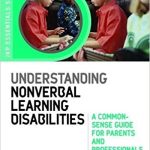 Understanding Nonverbal Learning Disabilities: A Common-Sense Guide for Parents and Professionals
Understanding Nonverbal Learning Disabilities: A Common-Sense Guide for Parents and Professionals
Maggie Mamen
This guide offers a complete overview of Nonverbal Learning Disabilities (NLDs) and the wide variety of symptoms that different types of NLD present. Maggie Mamen provides a wealth of practical advice on key skills such as developing written and verbal communication, understanding social clues, managing behaviour, self-regulation and organization.
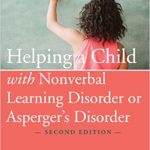 Helping a Child with Nonverbal Learning Disorder or Asperger’s Disorder: A Parent’s Guide
Helping a Child with Nonverbal Learning Disorder or Asperger’s Disorder: A Parent’s Guide
Kathryn Stewart
The book offers readers ways to evaluate their child’s strengths and weaknesses in areas such as visual and spatial functioning, writing problems, information processing and organizational skills, social and emotional capabilities, language skills, and interactive abilities. It offers specific strategies for intervening and helping the child to cope with these obstacles, such as teaching the child how to socialize with humor and empathy, alternatives for learning to write, tips for organizing daily activities, multi-tasking, and more.
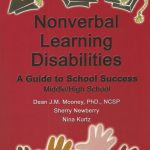 Nonverbal Learning Disabilities: A Guide to School Success (Middle/High School)
Nonverbal Learning Disabilities: A Guide to School Success (Middle/High School)
Dr. Dean Mooney, Sherry Newberry and Nina Kurtz
Nonverbal Learning Disabilities: A Guide to School Success shares the experience of three professionals who work with students with NLD in a variety of settings. Whether it is how to best present a writing assignment or how to ask a classmate to a dance, the authors have come to appreciate these students as creative, informed and personable. Rather than focusing on the limitations of this disability, these authors believe that with a quality comprehensive evaluation, a well-informed team, appropriate approaches, and the input of the student, academic and social success can be achieved!
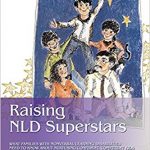 Raising NLD Superstars: What Families with Nonverbal Learning Disabilities Need to Know about Nurturing Confident, Competent Kids
Raising NLD Superstars: What Families with Nonverbal Learning Disabilities Need to Know about Nurturing Confident, Competent Kids
Marcia Brown Rubinstien
The author shares her experiences of life as the parent of a child with NLD with humanity and humour. Instead of insisting upon the one size fits all model of intervention, the she focuses on the individual nature of NLD children and offers practical, adaptable advice that will help them find their place both in the family and in wider social groups.
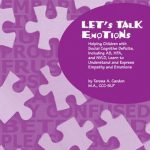 Let’s Talk Emotions: Helping Children with Social Cognitive Deficits, Including AS, HFA, and NVLD, Learn to Understand and Express Empathy and Emotions
Let’s Talk Emotions: Helping Children with Social Cognitive Deficits, Including AS, HFA, and NVLD, Learn to Understand and Express Empathy and Emotions
Teresa Cardon
Understanding emotions – their own and others’ – poses a major challenge for children with autism spectrum and other social cognitive challenges, causing frustration and misunderstanding and often behavioral outbursts. This collection of easy-to-use activities for children ages 4-18 gives parents, teachers, and others a valuable resource. Through a wide variety of experiences, children learn to identify and respond to their own feelings as well as the feelings of others, thereby improving their chances of maintaining and establishing fulfilling and successful social relationships.
 Nonverbal Learning Disabilities: Characteristics, Diagnosis and Treatment within an Educational Setting
Nonverbal Learning Disabilities: Characteristics, Diagnosis and Treatment within an Educational Setting
Marieke Molenaar-Klumper
The author provides an overview of the opinions expressed about NLD. She describes the cognitive, psychometric, socio-emotional and visual aspects, and also discusses how it can be diagnosed and how it associates itself with other conditions. She concludes by suggesting practical treatment strategies that can be applied at home and in school.
 Relationship Development Intervention with Young Children: Social and Emotional Development Activities for Asperger Syndrome, Autism, PDD and NLD
Relationship Development Intervention with Young Children: Social and Emotional Development Activities for Asperger Syndrome, Autism, PDD and NLD
Steven Gutstein
Friendship, even for the most able, requires hard work, and the odds are heavily stacked against those with autism spectrum conditions. Designed for younger children, typically between the ages of two and eight, this comprehensive set of enjoyable activities emphasizes foundation skills such as social referencing, regulating behavior, conversational reciprocity and synchronized actions. The authors include many objectives to plan and evaluate a child’s progress, each one related to a specific exercise. Suitable for parental use, the manual is also designed for easy implementation in schools and in therapeutic settings.
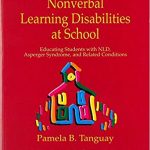 Nonverbal Learning Disabilities at School: Educating Students with NLD, Asperger Syndrome and Related Conditions
Nonverbal Learning Disabilities at School: Educating Students with NLD, Asperger Syndrome and Related Conditions
Pamela Tanguay
Topics such as finding the right school, curriculum modifications, and social and emotional issues experienced by children with NLD are covered. The bulk of the book outlines specific teaching strategies, from how to deal with essay questions, to tips on helping the student master long division and ideas for improving reading comprehension.
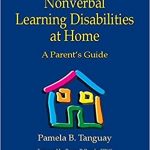 Nonverbal Learning Disabilities at Home: A Parent’s Guide
Nonverbal Learning Disabilities at Home: A Parent’s Guide
Pamela B. Tanguay
This book explores the problems children with NLD may face, and provides strategies for parents to help them cope and grow, from preschool age through their challenging adolescent years. The author provides solutions to the everyday challenges of the disorder, from early warning signs and self-care issues to social skills and personal safety.
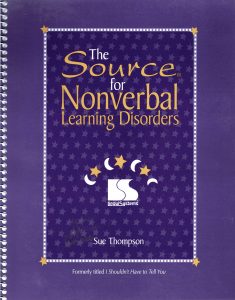 The Source for Nonverbal Learning Disorders
The Source for Nonverbal Learning Disorders
Sue Thompson
Sue Thompson’s book demystifies the nature and needs of children with Nonverbal Learning Disabilities. She translates scholarly research into an understandable manual for the identification and treatment of these children and youths. The book is filled with useful checklists, anecdotes, methods and resources.
 Misnamed, Misdiagnosed, Misunderstood: Recognizing and Coping with NVLD
Misnamed, Misdiagnosed, Misunderstood: Recognizing and Coping with NVLD
Linda Karanzalis
But the vast majority of human communication is non-verbal — body language, facial expressions, and tone of voice. Those with NVLD have trouble interpreting this non-verbal language and must rely on words alone to understand what others mean, which can lead to difficulties. Linda not only empowers others to achieve their goals but also serves as a role model offering understanding, hope, and inspiration to NVLDers of all ages.
 Understanding Nonverbal Learning Disability A Guide to Symptoms, Management, and Treatment 1st Edition
Understanding Nonverbal Learning Disability A Guide to Symptoms, Management, and Treatment 1st Edition
Irene C. Mammarella, Ramona Cardillo, Jessica Broitman
This essential book offers an accessible, evidence-based guide to Nonverbal Learning Disability (NVLD) informed by the most current research, and clinical and educational practice. It provides a thorough explanation of the science behind the condition, alongside ideas, support, and practical tips for managing the everyday challenges of the disorder at school and in family life.
 NLD from the Inside Out: Talking to Parents, Teachers, and Teens about Growing Up with Nonverbal Learning Disabilities
NLD from the Inside Out: Talking to Parents, Teachers, and Teens about Growing Up with Nonverbal Learning Disabilities
Michael Brian Murphy
Offering invaluable advice for teenagers and young adults with Nonverbal Learning Disabilities (NLD), this book explains what NLD is, how to understand your NLD brain, and how to thrive socially and academically. The book also includes guidance for parents, teachers and therapists on the issues that people with NLD want them to know.
 Screwed Up Somehow But Not Stupid, Life with a Learning Disability
Screwed Up Somehow But Not Stupid, Life with a Learning Disability
Peter Flom
When Peter Flom was five years old, his parents were told that he had “minimal brain dysfunction” and would never go to college. Peter skipped one year of high school, did college in three years, got his BA at twenty and now has two MAs and a Ph.D. He’s married and has two sons. He also has a different diagnosis: Nonverbal Learning Disability. In “Screwed Up Somehow but Not Stupid,” Peter describes what it’s like to live life with a learning disability, but also with some abilities.
 Smart but Stuck: Emotions in Teens and Adults with ADHD
Smart but Stuck: Emotions in Teens and Adults with ADHD
Thomas E. Brown
This book offers 15 true and compelling stories about intelligent, capable teens and adults who have gotten “stuck” at school, work, and/or in social relationships because of their ADHD. Dr. Brown highlights the often unrecognized role that emotions play in this complex disorder. He explains why even very bright people with ADHD get stuck because they can focus well on some tasks that interest them, but often can’t focus adequately on other important tasks and relationships.
 Life After High School: A Guide for Students with Disabilities and Their Families
Life After High School: A Guide for Students with Disabilities and Their Families
Susan Yellin, Christina Cacioppo Bertsch
Focussing specifically on the issues that affect students with disabilities, the authors offer advice on everything from dealing with college entrance exams and the college application process, to selecting the right college, visiting the campus, and achieving medical and financial independence away from home.
 The Social Success Workbook for Teens: Skill-Building Activities for Teens with Nonverbal Learning Disorder, Asperger’s Disorder, and Other Social-Skill Problems
The Social Success Workbook for Teens: Skill-Building Activities for Teens with Nonverbal Learning Disorder, Asperger’s Disorder, and Other Social-Skill Problems
Barbara Cooper MPS and Nancy Widdows MS
Making friends is a skill like any other-there are rules to follow, ways to measure your progress, and reasons why some people are better at it than others. Although it may seem like this skill comes naturally to those who don’t have Asperger’s disorder, nonverbal learning disorder (NLD), or other problems relating to others, the reality is that even the most popular people must constantly hone their abilities in order to make new friends and keep the friends they already have. This workbook includes forty activities you can do to recognize and use your unique strengths, understand the unspoken rules behind how people relate to each other, and improve your social skills.
 Thinking About YOU, Thinking About ME
Thinking About YOU, Thinking About ME
Michelle Garcia Winner
This is where to start to learn more about social interaction and social awareness. Understanding the perspectives of others is key to all interpersonal relationships. Many students, including those with high-functioning autism, Asperger’s syndrome, ADHD, and similar social and communication challenges, have difficulties understanding that other people have perspectives that are different from their own. Michelle’s model of perspective taking makes Theory of Mind research practical for teaching these students and even students who may be considered “neurotypical.”
 Nonverbal Learning Disabilities: A Guide to School Success (Middle/High School)
Nonverbal Learning Disabilities: A Guide to School Success (Middle/High School)
Dr. Dean Mooney, Sherry Newberry and Nina Kurtz
Nonverbal Learning Disabilities: A Guide to School Success shares the experience of three professionals who work with students with NLD in a variety of settings. Whether it is how to best present a writing assignment or how to ask a classmate to a dance, the authors have come to appreciate these students as creative, informed and personable. Rather than focusing on the limitations of this disability, these authors believe that with a quality comprehensive evaluation, a well-informed team, appropriate approaches, and the input of the student, academic and social success can be achieved!
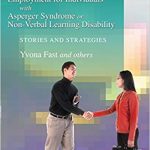 Employment for Individuals with Asperger Syndrome or Non-Verbal Learning Disability: Stories and Strategies
Employment for Individuals with Asperger Syndrome or Non-Verbal Learning Disability: Stories and Strategies
Yvona Fast and others
Most people with Non-Verbal Learning Disorder or AS are underemployed. This book sets out to change this. With practical advice on everything from job hunting to interview techniques, from ‘fitting in’ in the workplace to whether or not to disclose a diagnosis, this book guides people with NLD or AS successfully through the employment mine field.
 NVLD and Developmental Visual-Spatial Disorder in Children
NVLD and Developmental Visual-Spatial Disorder in Children
Amy Margolis, Ph.D.
This unique volume explores issues related to working with children who have nonverbal learning disability (NVLD). It examines how a child’s psychology – thoughts, feelings, beliefs – affects his or her functioning and learning. In addition, the book addresses how a child’s experiences are processed through individual personality, psychology, culture, environment and economic circumstances, and family dynamics. Using these psychological organizing principles, the book describes how to work most effectively with young patients with NVLD. It offers a new model and definition for understanding NVLD, emphasizing its core deficit of visual-spatial processing.
 Understanding Nonverbal Learning Disability A Guide to Symptoms, Management, and Treatment 1st Edition
Understanding Nonverbal Learning Disability A Guide to Symptoms, Management, and Treatment 1st Edition
Irene C. Mammarella, Ramona Cardillo, Jessica Broitman
This essential book offers an accessible, evidence-based guide to Nonverbal Learning Disability (NVLD) informed by the most current research, and clinical and educational practice. It provides a thorough explanation of the science behind the condition, alongside ideas, support, and practical tips for managing the everyday challenges of the disorder at school and in family life.
 Learning Disorders Across the Lifespan: A Mental Health Framework
Learning Disorders Across the Lifespan: A Mental Health Framework
Amy E. Margolis, Jessica Broitman
This book addresses the need to view specific learning disorders (SLDs) within a mental health framework and describes how policy and practice point to a different perspective – specifically that SLDs are often treated as educational rather than psychological problems – and examines the implications of this dichotomy.
 Nonverbal Learning Disorders: A School and Life Perspective
Nonverbal Learning Disorders: A School and Life Perspective
Gloria Hash Marcus
Gloria Hash Marcus’ book was written to assist parents, teachers, and students in understanding the dynamics of students with NVLD. Students with NVLD are often misunderstood by teachers and parents. NLD is a brain-based difference that has many strengths and weaknesses. Areas of strength typically include early speech and vocabulary development, precocious reading skills, and assets with spelling and rote memory skills. Challenging areas include visual-spatial concerns, motor control (including gross and fine motor skills), and social-emotional development. This book features a series of visual and interactive exercises.
 Nonverbal Learning Disabilities
Nonverbal Learning Disabilities
Cesare Cornoldi, Irene C. Mammarella, and Jodene Goldenring Fine
Increasing numbers of children and adolescents are being diagnosed with nonverbal learning disabilities (NLD), yet clinicians and educators have few scientific resources to guide assessment and intervention. This book presents up-to-date knowledge on the nature of NLD and how to differentiate it from DSM-5 disorders such as autism spectrum disorder and developmental coordination disorder. Effective strategies for helping K-12 students and their families address the challenges of NLD in and outside of the classroom are illustrated with vivid case material. The authors thoughtfully consider controversies surrounding NLD, discuss why the diagnosis is not included in the current DSM and ICD classification systems, and identify important directions for future research.
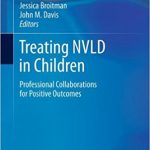 Treating NVLD in Children: Professional Collaborations for Positive Outcomes
Treating NVLD in Children: Professional Collaborations for Positive Outcomes
Jessica Broitman, John M. Davis (editors)
Children with nonverbal learning disabilities (NVLD) have needs that can take many forms and may, over time, require consultation and collaboration with professionals from several fields. Given that multiple specialists may be involved in working with children with NVLD – as well as the array of treatment variables – even seasoned practitioners may find themselves in confusing situation.
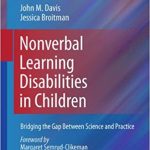 Nonverbal Learning Disabilities in Children: Bridging the Gap Between Science and Practice
Nonverbal Learning Disabilities in Children: Bridging the Gap Between Science and Practice
John M. Davis, Jessica Broitman
Although it has yet to be recognized by the American Psychiatric Association’s Diagnostic and Statistical Manual (DSM), nonverbal learning disabilities (NVLD) in children are a growing concern. NVLD are receiving increased attention from researchers as well as from clinicians encountering these conditions in their young clients. At the same time, reliable information on effective interventions for NVLD has lagged behind this interest.
 A Special Kind of Brain: Living with Nonverbal Learning Disability
A Special Kind of Brain: Living with Nonverbal Learning Disability
Nancy Russell Burger
Sharing the experience of bringing up a child with nonverbal learning disability (NLD), this warm and accessible book offers advice on subjects ranging across diagnosis and therapy, children’s interaction with each other, suitable activities for a child with NLD and how to discuss NLD with children. An essential guide, this book will reassure, advise and inform parents and professionals who work with children with NLD.
 Nonverbal Learning Disorder: Understanding and Coping with NLD and Asperger’s-What Parents and Teachers Need to Know
Nonverbal Learning Disorder: Understanding and Coping with NLD and Asperger’s-What Parents and Teachers Need to Know
Rondalyn Varney Whitney
Millions of children suffer from Nonverbal Learning Disorder, a neurological deficit that prevents them from understanding nonverbal cues like tone of voice and facial expressions. Though they can be exceptionally bright and articulate, these children often have difficulty in social situations, and can become depressed, withdrawn, or anxious.
 Making Sense of Children’s Thinking and Behavior: A Step-by-Step Tool for Understanding Children with NLD, Asperger’s, HFA, PDD-NOS, and other Neurological Differences
Making Sense of Children’s Thinking and Behavior: A Step-by-Step Tool for Understanding Children with NLD, Asperger’s, HFA, PDD-NOS, and other Neurological Differences
Leslie Holzhauser-Peters and Leslie True
This book offers a tool for understanding children with neurological differences. Often, the child’s actions are misunderstood and, consequently, they are unfairly punished. The authors’ Systematic Tool for Analyzing Thinking (STAT) provides a step-by-step method for understanding a child’s behavior by revealing the thought processes behind it.
 Helping Children with Nonverbal Learning Disabilities to Flourish: A Guide for Parents and Professionals
Helping Children with Nonverbal Learning Disabilities to Flourish: A Guide for Parents and Professionals
Marilyn Martin
Martin presents a comprehensive developmental profile of children with NLD. She helps parents and professionals to identify learners with NLD and insure they receive early intervention. Offering practical advice on NLD at home and at school, she describes step-by-step interventions for improving a range of skills from penmanship to social acumen.
 Understanding Nonverbal Learning Disabilities: A Common-Sense Guide for Parents and Professionals
Understanding Nonverbal Learning Disabilities: A Common-Sense Guide for Parents and Professionals
Maggie Mamen
This guide offers a complete overview of Nonverbal Learning Disabilities (NLDs) and the wide variety of symptoms that different types of NLD present. Maggie Mamen provides a wealth of practical advice on key skills such as developing written and verbal communication, understanding social clues, managing behaviour, self-regulation and organization.
 Nonverbal Learning Disabilities
Nonverbal Learning Disabilities
Joseph Palombo
A nonverbal learning disability (NLD) is a developmental disorder that impairs a person’s capacity to perceive, express, and understand nonverbal (nonlinguistic) signs. The dysfunctions affect behaviors, social interactions, perceptions and feelings regarding oneself and others, and emerging personality patterns. NLD constrains an individual’s capacity to function in a wide variety of domains, including the academic, social, emotional, and vocational. Parents and clinicians often have difficulty understanding and helping children and adolescents who are simultaneously cherished and whose functioning is hampered by the condition.
 Nonverbal Learning Disabilities: A Guide to School Success (Middle/High School)
Nonverbal Learning Disabilities: A Guide to School Success (Middle/High School)
Dr. Dean Mooney, Sherry Newberry and Nina Kurtz
Nonverbal Learning Disabilities: A Guide to School Success shares the experience of three professionals who work with students with NLD in a variety of settings. Whether it is how to best present a writing assignment or how to ask a classmate to a dance, the authors have come to appreciate these students as creative, informed and personable. Rather than focusing on the limitations of this disability, these authors believe that with a quality comprehensive evaluation, a well-informed team, appropriate approaches, and the input of the student, academic and social success can be achieved!
 Let’s Talk Emotions: Helping Children with Social Cognitive Deficits, Including AS, HFA, and NVLD, Learn to Understand and Express Empathy and Emotions
Let’s Talk Emotions: Helping Children with Social Cognitive Deficits, Including AS, HFA, and NVLD, Learn to Understand and Express Empathy and Emotions
Teresa Cardon
Understanding emotions – their own and others’ – poses a major challenge for children with autism spectrum and other social cognitive challenges, causing frustration and misunderstanding and often behavioral outbursts. This collection of easy-to-use activities for children ages 4-18 gives parents, teachers, and others a valuable resource. Through a wide variety of experiences, children learn to identify and respond to their own feelings as well as the feelings of others, thereby improving their chances of maintaining and establishing fulfilling and successful social relationships.
 Nonverbal Learning Disabilities: Characteristics, Diagnosis and Treatment within an Educational Setting
Nonverbal Learning Disabilities: Characteristics, Diagnosis and Treatment within an Educational Setting
Marieke Molenaar-Klumper
The author provides an overview of the opinions expressed about NLD. She describes the cognitive, psychometric, socio-emotional and visual aspects, and also discusses how it can be diagnosed and how it associates itself with other conditions. She concludes by suggesting practical treatment strategies that can be applied at home and in school.
 Relationship Development Intervention with Young Children: Social and Emotional Development Activities for Asperger Syndrome, Autism, PDD and NLD
Relationship Development Intervention with Young Children: Social and Emotional Development Activities for Asperger Syndrome, Autism, PDD and NLD
Steven Gutstein
Friendship, even for the most able, requires hard work, and the odds are heavily stacked against those with autism spectrum conditions. Designed for younger children, typically between the ages of two and eight, this comprehensive set of enjoyable activities emphasizes foundation skills such as social referencing, regulating behavior, conversational reciprocity and synchronized actions. The authors include many objectives to plan and evaluate a child’s progress, each one related to a specific exercise. Suitable for parental use, the manual is also designed for easy implementation in schools and in therapeutic settings.
 Nonverbal Learning Disabilities at School: Educating Students with NLD, Asperger Syndrome and Related Conditions
Nonverbal Learning Disabilities at School: Educating Students with NLD, Asperger Syndrome and Related Conditions
Pamela Tanguay
Topics such as finding the right school, curriculum modifications, and social and emotional issues experienced by children with NLD are covered. The bulk of the book outlines specific teaching strategies, from how to deal with essay questions, to tips on helping the student master long division and ideas for improving reading comprehension.
 The Source for Nonverbal Learning Disorders
The Source for Nonverbal Learning Disorders
Sue Thompson
Sue Thompson’s book demystifies the nature and needs of children with Nonverbal Learning Disabilities. She translates scholarly research into an understandable manual for the identification and treatment of these children and youths. The book is filled with useful checklists, anecdotes, methods and resources.
 Syndrome of Nonverbal Learning Disabilities: Neurodevelopmental Manifestations
Syndrome of Nonverbal Learning Disabilities: Neurodevelopmental Manifestations
Byron P. Rourke
Recommended for neuropsychologists, neurologists, psychologists, psychiatrists, and pediatricians treating children with learning disabilities or with pediatric neurological disease, disorder, and dysfunction, Syndrome of Nonverbal Learning Disabilities serves both as an authoritative update on recent advances and as a text for advanced courses in child/developmental neuropsychology, pediatric neurology, and learning disabilities.
